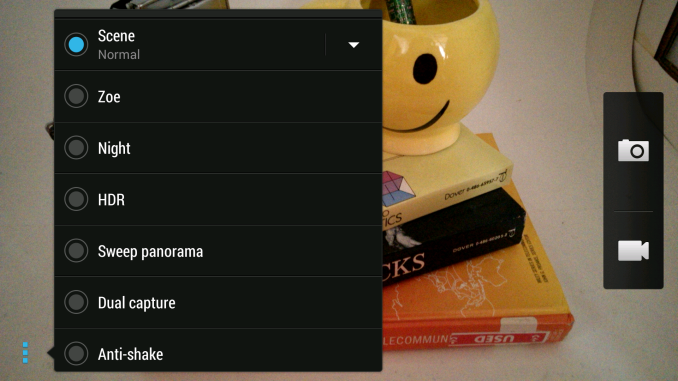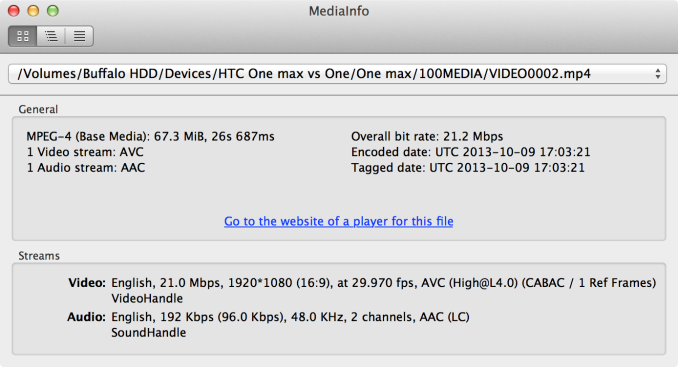HTC One max Review - It's Huge
by Brian Klug on October 28, 2013 10:00 AM EST- Posted in
- Smartphones
- HTC
- Mobile
- One
- Snapdragon 600
- Android 4.3
- One max
On the camera side we see HTC’s continued use of the 4 MP UltraPixel camera sensor on the back, with 2.0 micron pixels and 1/3" size. It’s the same CMOS sensor from ST (VD6869), and the same optics on top, with 3.8mm focal length and F/2.0 aperture. What’s different is that the One max doesn’t have OIS (Optical Image Stabilization), just like the One mini. That’s a bit unfortunate since OIS was one of the real highlights of the One, and we’ve seen another OEM follow suit with the inclusion of OIS to good success (LG’s G2) and will likely see Samsung do the same. On the front facing camera we have an Aptina AS0260 CMOS sensor with 2.1 MP resolution and 1.4µm pixels.
| HTC One Camera Specifications | |||||
| Device | HTC One | HTC One max/mini | |||
| Sensor Size and Type | 1/3" BSI CMOS | 1/3" BSI CMOS | |||
| Resolution | 4.0 MP 16:9 Aspect Ratio (2688 x 1520) | 4.0 MP 16:9 Aspect Ratio (2688 x 1520) | |||
| Focal Length | 3.82mm | 3.82 mm | |||
| F/# | F/2.0 | F/2.0 | |||
| Optical System | 5P | 5P | |||
| OIS | 2-axis +/- 1 degree, 2 kHz sampling | No OIS | |||
My thoughts about the HTC One camera system have definitely evolved over time, though I’m still glad HTC took a big risk and went this way, I’d like to see resolution traded off a bit less in the next generation. Good imaging often takes a balanced approach, I’d love to see larger pixels somewhere around 1.65 µm and as many as possible while still being pragmatic about sensor size. I hate to bring up the iPhone 5s as a comparison point, but something without as far of a tradeoff would be great. I’m still a fan of the HTC One camera indoors where other cameras struggle, but outdoors the resolution tradeoff is definitely there. Losing OIS means losing one of the things about the One system that made it special and standout in my mind. I could understand it being gone in the One mini for cost reasons, but the One max really should’ve had it considering its mission – everything about the One, taken to the max.
There’s a couple new features in the camera as a part of Sense 5.5 as well. Dual capture has been added to the camera as a shooting mode. We’ve seen this from other OEMs – it allows the front facing camera to be superimposed on the rear facing camera, or vice versus.
It’s a great feature for taking a selfie in front of something while traveling, which is ultimately its primary use case, I guess. There’s also an ‘anti shake’ mode which seems to be an EIS enhanced mode, but again this doesn’t preclude getting blurry pictures when the One max takes longer exposures, from what I’ve found.
Gallery: Smartphone Camera Bench
With the exception the performance tradeoff that comes from lacking OIS (higher chance of getting blurry photos from hand shake), imaging performance on the One max is really unchanged versus the One or One mini. I’m not going to go into super great detail here, but again I’d love to see the future One series a bit more resolution without trading off too much sensitivity.
Video
The One max has the same set of video modes as the other One, normal 1080p30, slow motion video, fast HD (720p60) and Video HDR (1080p30). In addition the shot in shot mode also works in video, so you can have yourself superimposed over video of whatever you’re shooting as well.
Video is recorded at a maximum of 1080p30 H.264 high profile with a 21 Mbps bitrate, and stereo audio. 1080p30 is great, but it’d be awesome to see 4K UHD video record which I was spoiled by on the Note 3, that’s another thing that’s a matter of SoC and CMOS needing a bit more.
I took videos on the One max at the standard bench location (MP4) and also compared to the One with OIS to illustrate the tradeoff in stabilized video that comes with its removal. I think it’s fairly easy to make the case that it should’ve been there. I also swear I wiped down the One max front facing glass to prevent glare, but the One max video shows some haze from light leakage. I’d love to see more OEMs move to coated sapphire cover glass on the camera, something I don’t believe HTC has.























































197 Comments
View All Comments
GruntboyX - Monday, October 28, 2013 - link
I love how the dimensions are reported in mm. However the screen size is in inches.MercuryStar - Tuesday, October 29, 2013 - link
As an Australian, this is absolutely normal here - we use mm for dimensions of all things except for diagonal screen size which is pretty much always quoted in inches - for everything from laptops to TVs to smartphones.nerd1 - Monday, October 28, 2013 - link
I always liked Brian's review for the most part for this time it's getting ridiculous.iPhone 5GS 64GB: $399 w/contract
Galaxy 4S 80GB (16GB+64GB sdXC): $199 w/ contract
Isn't it obvious to see the advantage? If you always have a bunch of 64GB devices around to review (and unlimited LTE) for free you may not know but to us mortals the saving of $200 far exceeds any inconveniences (if all) of managing them.
It's like arguing having only a single SSD storage for laptop is better than SSD+HDD hybrid because the former is faster, lighter and more failproof. Problem is not everyone can purchase 1TB of PCIe SSD, and some people prefer 128 SSD + 1TB HDD setup at a fraction of the cost.
MercuryStar - Tuesday, October 29, 2013 - link
I don't think the author is claiming that SD cards slots are bad, just that very few people use them, or would use the added capacity they would provide, thus making them a lower relative priority compared to other things like, in the case of this phone, added thickness and weight of the removable back.Someone else was saying in another comment that carriers who bundled phones with a free SD card in the box found that the majority of people still didn't use the SD card.
chizow - Tuesday, October 29, 2013 - link
I guess it never occurred to them that the bundled SD card is basically useless due to it's capacity and not it's utility? I don't use them either but with 2GB storage I can't even use to load a Windows ISO. I leave them in the box too, but replace them with my own 32 or 64GB card.....chizow - Tuesday, October 29, 2013 - link
Exactly, it's like all the reviewers out there getting free 128GB iPads to review and totally understanding Apple's position about not including a microSD slot. Yet they don't realize, most people don't want to pay $800-$900 for 128GB of storage and Cellular over the base $500 model....Mr Majestyk - Monday, October 28, 2013 - link
Why is the Sony Z Ultra missing, much more compelling device to me than One Max? Also why use 4 decimal places on the max brightness? Really, we don't even need a single decimal place for this measure, just round it to nearest integer. Human eye can't tell minute changes in brightness at the bright end, like it can at the dark end.piroroadkill - Tuesday, October 29, 2013 - link
Sony are killing it at the moment, in my opinion.By FAR the best mid-range handset for the money is the Xperia SP. At the high end you have the Xperia Z1, then for people who have gorilla hands, the Z Ultra.
All better phones than their counterparts by other manufacturers like HTC or Samsung. Yet, where are the reviews?
synaesthetic - Monday, October 28, 2013 - link
The amount of logical fallacies being committed in this comments section is staggering.Personally I'd prefer sdcard slots in my phones, but the reality is most people don't care or don't know or aren't familiar with their use. They're going away, slowly but surely. Samsung and Sony are really the only holdouts, with the exception of bargain-basement budget devices that cut internal eMMC down to 4GB or smaller to keep BOM cost as low as possible.
Those of us who want our phones to be purely functional powerhouses of mobile computing are sadly in the minority, and the market is absolutely a tyranny of the majority.
bairlangga - Monday, October 28, 2013 - link
Agree. Just snapped a 64gb sdxc uhs1 on my xperia yesterday. Couldn't be much happier ;-)